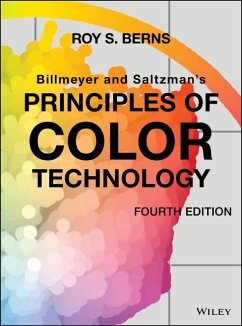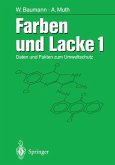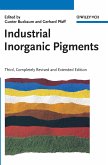Roy S. Berns
Billmeyer and Saltzman's Principles of Color Technology
Roy S. Berns
Billmeyer and Saltzman's Principles of Color Technology
- Gebundenes Buch
- Merkliste
- Auf die Merkliste
- Bewerten Bewerten
- Teilen
- Produkt teilen
- Produkterinnerung
- Produkterinnerung
This book offers detailed coverage of color, colorants, the coloring of materials, and reproducing the color of materials through imaging. It combines the clarity and ease of earlier editions with significant updates about the advancement in color theory and technology. _ Provides guidance for how to use color measurement instrumentation, make a visual assessment, set a visual tolerance, and select a formulation _ Supplements material with numerical examples, graphs, and illustrations that clarify and explain complex subjects _ Expands coverage of topics including spatial vision, solid-state…mehr
Andere Kunden interessierten sich auch für
![Farben und Lacke Farben und Lacke]() Werner BaumannFarben und Lacke349,99 €
Werner BaumannFarben und Lacke349,99 €![Industrial Organic Pigments Industrial Organic Pigments]() Klaus HungerIndustrial Organic Pigments213,99 €
Klaus HungerIndustrial Organic Pigments213,99 €![Die Bleichmittel, Beizen und Farbstoffe Die Bleichmittel, Beizen und Farbstoffe]() Jacob HerzfeldDie Bleichmittel, Beizen und Farbstoffe34,90 €
Jacob HerzfeldDie Bleichmittel, Beizen und Farbstoffe34,90 €![Die Bleichmittel, Beizen und Farbstoffe Die Bleichmittel, Beizen und Farbstoffe]() Jacob HerzfeldDie Bleichmittel, Beizen und Farbstoffe42,90 €
Jacob HerzfeldDie Bleichmittel, Beizen und Farbstoffe42,90 €![Automotive Paints and Coatings Automotive Paints and Coatings]() StreitbergerAutomotive Paints and Coatings223,99 €
StreitbergerAutomotive Paints and Coatings223,99 €![Industrial Inorganic Pigments Industrial Inorganic Pigments]() Gunter BuxbaumIndustrial Inorganic Pigments311,99 €
Gunter BuxbaumIndustrial Inorganic Pigments311,99 €![70th Conference on Glass Problems, Volume 31, Issue 1 70th Conference on Glass Problems, Volume 31, Issue 1]() 70th Conference on Glass Problems, Volume 31, Issue 1122,99 €
70th Conference on Glass Problems, Volume 31, Issue 1122,99 €-
-
-
This book offers detailed coverage of color, colorants, the coloring of materials, and reproducing the color of materials through imaging. It combines the clarity and ease of earlier editions with significant updates about the advancement in color theory and technology.
_ Provides guidance for how to use color measurement instrumentation, make a visual assessment, set a visual tolerance, and select a formulation
_ Supplements material with numerical examples, graphs, and illustrations that clarify and explain complex subjects
_ Expands coverage of topics including spatial vision, solid-state lighting, cameras and spectrophotometers, and translucent materials
Hinweis: Dieser Artikel kann nur an eine deutsche Lieferadresse ausgeliefert werden.
_ Provides guidance for how to use color measurement instrumentation, make a visual assessment, set a visual tolerance, and select a formulation
_ Supplements material with numerical examples, graphs, and illustrations that clarify and explain complex subjects
_ Expands coverage of topics including spatial vision, solid-state lighting, cameras and spectrophotometers, and translucent materials
Hinweis: Dieser Artikel kann nur an eine deutsche Lieferadresse ausgeliefert werden.
Produktdetails
- Produktdetails
- Verlag: Wiley / Wiley & Sons
- Artikelnr. des Verlages: 1W119367220
- 4. Aufl.
- Seitenzahl: 272
- Erscheinungstermin: 9. April 2019
- Englisch
- Abmessung: 283mm x 224mm x 20mm
- Gewicht: 1030g
- ISBN-13: 9781119367222
- ISBN-10: 1119367220
- Artikelnr.: 55578185
- Herstellerkennzeichnung
- Libri GmbH
- Europaallee 1
- 36244 Bad Hersfeld
- gpsr@libri.de
- Verlag: Wiley / Wiley & Sons
- Artikelnr. des Verlages: 1W119367220
- 4. Aufl.
- Seitenzahl: 272
- Erscheinungstermin: 9. April 2019
- Englisch
- Abmessung: 283mm x 224mm x 20mm
- Gewicht: 1030g
- ISBN-13: 9781119367222
- ISBN-10: 1119367220
- Artikelnr.: 55578185
- Herstellerkennzeichnung
- Libri GmbH
- Europaallee 1
- 36244 Bad Hersfeld
- gpsr@libri.de
ROY S. BERNS, PHD, is the Richard S. Hunter Professor in Color Science, Appearance, and Technology within the Program of Color Science at Rochester Institute of Technology, USA where he developed both M.S. and Ph.D. degree programs in Color Science. He has received scientific achievement awards from the Inter-Society Color Council, the Society of Imaging Science and Technology, the Colour Group of Great Britain, and the International Association of Colour. Dr. Berns is the author of the third edition of this book, as well as an author of over 200 publications.
Preface xi
Chapter 1 Physical Properties of Colors 1
A What this Book is about? 1
B The Spectrum and Wave Theory 2
C Light Sources 3
D Conventional Materials 5
Transmission 5
Absorption 6
Surface Scattering 7
Internal Scattering 7
Terminology - Dyes Versus Pigments 10
Spectral Characteristics of Conventional Materials 12
E Fluorescent Materials 12
F Gonioapparent Materials 14
Metallic Materials 14
Pearlescent Materials 14
Interference Materials 15
Diffraction Materials 16
G Photochromic and Thermochromic Colorants 16
H Summary 16
Chapter 2 Color and Spatial Vision 17
A Trichromacy 17
B Light and Chromatic adaptation 21
C Compression 23
D Opponency 23
E Spatial Vision 26
F Observer variability 29
G Summary 34
Chapter 3 Visual Color Specification 37
A One-Dimensional Scales 37
Hue 37
Lightness 38
Chromatic Intensity 39
B Three-Dimensional Systems 39
Geometries 39
Natural Color System 40
Munsell Color System 42
Other Color-Order Systems 46
C Color Appearance: Multidimensional systems 46
D Color-Mixing systems 47
RGB and HSB 47
The Pantone Matching System 48
Limitations of Color-Mixing Systems for Color Specification 49
E Summary 49
Chapter 4 Numerical Color Specification: Colorimetry 51
A Color Matching 51
B Derivation of the Standard observers 53
Theoretical Considerations 53
The Color-Matching Experiment 54
The 1924 CIE Standard Photopic Observer 57
The 1931 CIE Standard Colorimetric Observer 58
The 1964 CIE Standard Colorimetric Observer 61
Cone-Fundamental-Based Colorimetric Observers 62
C Calculating Tristimulus values for Materials 62
D Chromaticity Coordinates and the Chromaticity diagram 63
E Calculating Tristimulus values and Chromaticity Coordinates for sources 67
F Transformation of Primaries 68
Displays 68
Cone Fundamentals 71
G Approximately Uniformly Spaced Systems 71
L* Lightness 72
u'v' Uniform-Chromaticity Scale Diagram 72
Cieluv 73
Cielab 74
Rotation of CIELAB Coordinates 75
H Color-appearance models 78
I Whiteness and Yellowness 83
Whiteness 83
Yellowness 84
J Summary 84
Chapter 5 Color-Quality Specification 85
A Perceptibility and Acceptability Visual Judgments 85
B Color-Difference Geometry 86
C Ellipses and Ellipsoids 89
D The Color-Difference Problem 92
E Weighted Color-Difference Formulas 96
F CMC(L:C) Color-Difference Formula 99
G Ciede2000 Color-Difference Formula 100
H Uniform Color-Difference Spaces 105
I Determining Color-Tolerance Magnitude 106
J Summary 110
Chapter 6 Color and Material-Appearance Measurement 111
A Basic Principles of Measuring Color and Material Appearance 111
B The Sample 112
C Visual Color Measurement 113
D Measurement geometries 114
Bidirectional Reflectance Distribution Function 115
CIE Recommended Geometries for Measuring Spectral Reflectance Factor 115
CIE Recommended Geometries for Measuring Spectral Transmittance Factor 118
Multiangle Geome
Chapter 1 Physical Properties of Colors 1
A What this Book is about? 1
B The Spectrum and Wave Theory 2
C Light Sources 3
D Conventional Materials 5
Transmission 5
Absorption 6
Surface Scattering 7
Internal Scattering 7
Terminology - Dyes Versus Pigments 10
Spectral Characteristics of Conventional Materials 12
E Fluorescent Materials 12
F Gonioapparent Materials 14
Metallic Materials 14
Pearlescent Materials 14
Interference Materials 15
Diffraction Materials 16
G Photochromic and Thermochromic Colorants 16
H Summary 16
Chapter 2 Color and Spatial Vision 17
A Trichromacy 17
B Light and Chromatic adaptation 21
C Compression 23
D Opponency 23
E Spatial Vision 26
F Observer variability 29
G Summary 34
Chapter 3 Visual Color Specification 37
A One-Dimensional Scales 37
Hue 37
Lightness 38
Chromatic Intensity 39
B Three-Dimensional Systems 39
Geometries 39
Natural Color System 40
Munsell Color System 42
Other Color-Order Systems 46
C Color Appearance: Multidimensional systems 46
D Color-Mixing systems 47
RGB and HSB 47
The Pantone Matching System 48
Limitations of Color-Mixing Systems for Color Specification 49
E Summary 49
Chapter 4 Numerical Color Specification: Colorimetry 51
A Color Matching 51
B Derivation of the Standard observers 53
Theoretical Considerations 53
The Color-Matching Experiment 54
The 1924 CIE Standard Photopic Observer 57
The 1931 CIE Standard Colorimetric Observer 58
The 1964 CIE Standard Colorimetric Observer 61
Cone-Fundamental-Based Colorimetric Observers 62
C Calculating Tristimulus values for Materials 62
D Chromaticity Coordinates and the Chromaticity diagram 63
E Calculating Tristimulus values and Chromaticity Coordinates for sources 67
F Transformation of Primaries 68
Displays 68
Cone Fundamentals 71
G Approximately Uniformly Spaced Systems 71
L* Lightness 72
u'v' Uniform-Chromaticity Scale Diagram 72
Cieluv 73
Cielab 74
Rotation of CIELAB Coordinates 75
H Color-appearance models 78
I Whiteness and Yellowness 83
Whiteness 83
Yellowness 84
J Summary 84
Chapter 5 Color-Quality Specification 85
A Perceptibility and Acceptability Visual Judgments 85
B Color-Difference Geometry 86
C Ellipses and Ellipsoids 89
D The Color-Difference Problem 92
E Weighted Color-Difference Formulas 96
F CMC(L:C) Color-Difference Formula 99
G Ciede2000 Color-Difference Formula 100
H Uniform Color-Difference Spaces 105
I Determining Color-Tolerance Magnitude 106
J Summary 110
Chapter 6 Color and Material-Appearance Measurement 111
A Basic Principles of Measuring Color and Material Appearance 111
B The Sample 112
C Visual Color Measurement 113
D Measurement geometries 114
Bidirectional Reflectance Distribution Function 115
CIE Recommended Geometries for Measuring Spectral Reflectance Factor 115
CIE Recommended Geometries for Measuring Spectral Transmittance Factor 118
Multiangle Geome
Preface xi
Chapter 1 Physical Properties of Colors 1
A What this Book is about? 1
B The Spectrum and Wave Theory 2
C Light Sources 3
D Conventional Materials 5
Transmission 5
Absorption 6
Surface Scattering 7
Internal Scattering 7
Terminology - Dyes Versus Pigments 10
Spectral Characteristics of Conventional Materials 12
E Fluorescent Materials 12
F Gonioapparent Materials 14
Metallic Materials 14
Pearlescent Materials 14
Interference Materials 15
Diffraction Materials 16
G Photochromic and Thermochromic Colorants 16
H Summary 16
Chapter 2 Color and Spatial Vision 17
A Trichromacy 17
B Light and Chromatic adaptation 21
C Compression 23
D Opponency 23
E Spatial Vision 26
F Observer variability 29
G Summary 34
Chapter 3 Visual Color Specification 37
A One-Dimensional Scales 37
Hue 37
Lightness 38
Chromatic Intensity 39
B Three-Dimensional Systems 39
Geometries 39
Natural Color System 40
Munsell Color System 42
Other Color-Order Systems 46
C Color Appearance: Multidimensional systems 46
D Color-Mixing systems 47
RGB and HSB 47
The Pantone Matching System 48
Limitations of Color-Mixing Systems for Color Specification 49
E Summary 49
Chapter 4 Numerical Color Specification: Colorimetry 51
A Color Matching 51
B Derivation of the Standard observers 53
Theoretical Considerations 53
The Color-Matching Experiment 54
The 1924 CIE Standard Photopic Observer 57
The 1931 CIE Standard Colorimetric Observer 58
The 1964 CIE Standard Colorimetric Observer 61
Cone-Fundamental-Based Colorimetric Observers 62
C Calculating Tristimulus values for Materials 62
D Chromaticity Coordinates and the Chromaticity diagram 63
E Calculating Tristimulus values and Chromaticity Coordinates for sources 67
F Transformation of Primaries 68
Displays 68
Cone Fundamentals 71
G Approximately Uniformly Spaced Systems 71
L* Lightness 72
u'v' Uniform-Chromaticity Scale Diagram 72
Cieluv 73
Cielab 74
Rotation of CIELAB Coordinates 75
H Color-appearance models 78
I Whiteness and Yellowness 83
Whiteness 83
Yellowness 84
J Summary 84
Chapter 5 Color-Quality Specification 85
A Perceptibility and Acceptability Visual Judgments 85
B Color-Difference Geometry 86
C Ellipses and Ellipsoids 89
D The Color-Difference Problem 92
E Weighted Color-Difference Formulas 96
F CMC(L:C) Color-Difference Formula 99
G Ciede2000 Color-Difference Formula 100
H Uniform Color-Difference Spaces 105
I Determining Color-Tolerance Magnitude 106
J Summary 110
Chapter 6 Color and Material-Appearance Measurement 111
A Basic Principles of Measuring Color and Material Appearance 111
B The Sample 112
C Visual Color Measurement 113
D Measurement geometries 114
Bidirectional Reflectance Distribution Function 115
CIE Recommended Geometries for Measuring Spectral Reflectance Factor 115
CIE Recommended Geometries for Measuring Spectral Transmittance Factor 118
Multiangle Geome
Chapter 1 Physical Properties of Colors 1
A What this Book is about? 1
B The Spectrum and Wave Theory 2
C Light Sources 3
D Conventional Materials 5
Transmission 5
Absorption 6
Surface Scattering 7
Internal Scattering 7
Terminology - Dyes Versus Pigments 10
Spectral Characteristics of Conventional Materials 12
E Fluorescent Materials 12
F Gonioapparent Materials 14
Metallic Materials 14
Pearlescent Materials 14
Interference Materials 15
Diffraction Materials 16
G Photochromic and Thermochromic Colorants 16
H Summary 16
Chapter 2 Color and Spatial Vision 17
A Trichromacy 17
B Light and Chromatic adaptation 21
C Compression 23
D Opponency 23
E Spatial Vision 26
F Observer variability 29
G Summary 34
Chapter 3 Visual Color Specification 37
A One-Dimensional Scales 37
Hue 37
Lightness 38
Chromatic Intensity 39
B Three-Dimensional Systems 39
Geometries 39
Natural Color System 40
Munsell Color System 42
Other Color-Order Systems 46
C Color Appearance: Multidimensional systems 46
D Color-Mixing systems 47
RGB and HSB 47
The Pantone Matching System 48
Limitations of Color-Mixing Systems for Color Specification 49
E Summary 49
Chapter 4 Numerical Color Specification: Colorimetry 51
A Color Matching 51
B Derivation of the Standard observers 53
Theoretical Considerations 53
The Color-Matching Experiment 54
The 1924 CIE Standard Photopic Observer 57
The 1931 CIE Standard Colorimetric Observer 58
The 1964 CIE Standard Colorimetric Observer 61
Cone-Fundamental-Based Colorimetric Observers 62
C Calculating Tristimulus values for Materials 62
D Chromaticity Coordinates and the Chromaticity diagram 63
E Calculating Tristimulus values and Chromaticity Coordinates for sources 67
F Transformation of Primaries 68
Displays 68
Cone Fundamentals 71
G Approximately Uniformly Spaced Systems 71
L* Lightness 72
u'v' Uniform-Chromaticity Scale Diagram 72
Cieluv 73
Cielab 74
Rotation of CIELAB Coordinates 75
H Color-appearance models 78
I Whiteness and Yellowness 83
Whiteness 83
Yellowness 84
J Summary 84
Chapter 5 Color-Quality Specification 85
A Perceptibility and Acceptability Visual Judgments 85
B Color-Difference Geometry 86
C Ellipses and Ellipsoids 89
D The Color-Difference Problem 92
E Weighted Color-Difference Formulas 96
F CMC(L:C) Color-Difference Formula 99
G Ciede2000 Color-Difference Formula 100
H Uniform Color-Difference Spaces 105
I Determining Color-Tolerance Magnitude 106
J Summary 110
Chapter 6 Color and Material-Appearance Measurement 111
A Basic Principles of Measuring Color and Material Appearance 111
B The Sample 112
C Visual Color Measurement 113
D Measurement geometries 114
Bidirectional Reflectance Distribution Function 115
CIE Recommended Geometries for Measuring Spectral Reflectance Factor 115
CIE Recommended Geometries for Measuring Spectral Transmittance Factor 118
Multiangle Geome








